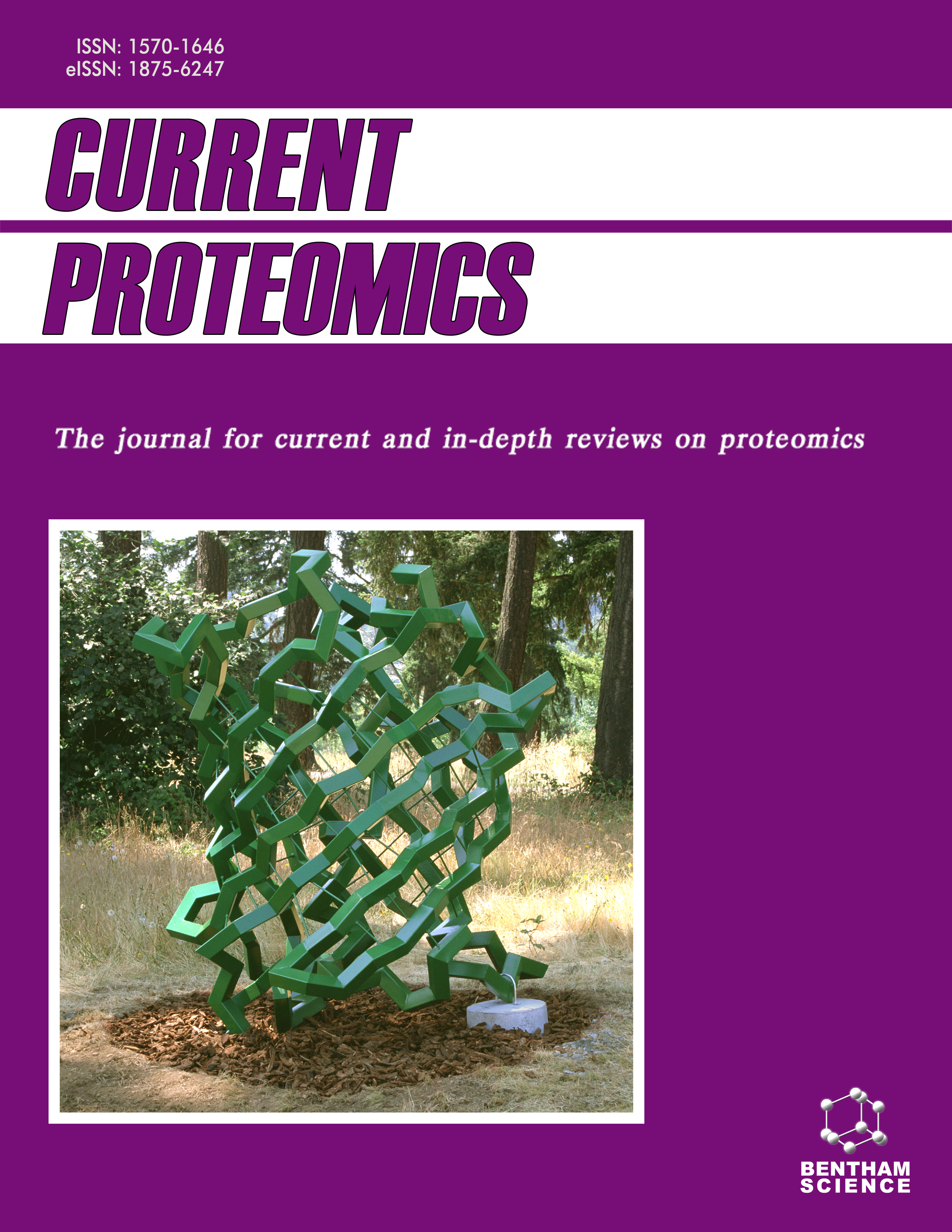Current Proteomics - Volume 3, Issue 2, 2006
Volume 3, Issue 2, 2006
-
-
Causes and Diagnosis of Alzheimer's Disease: A Proteomics Approach
More LessAuthors: Anne Poljak, Perminder Sachdev and George A. SmytheProteomics has become a powerful tool facilitating hypothesis-driven exploration of disease states as well as offering a global approach which can uncover potentially important, though unexpected links to disease etiology. Despite many recent advances, the pathophysiological basis of Alzheimer's disease is incompletely understood. Alzheimer's dementia almost certainly results from a constellation of cellular changes, with considerable interplay between multiple genetic and environmental factors. As a multifactorial disease, it is an ideal candidate for a proteomics approach which offers a broad spectrum view of changes to protein expression. The use of proteomics in the study of Alzheimer's dementia is in its early days. However, its importance as an approach to the study of this disease has been recognized by a considerable number of review papers on this topic. This review summarises the advances that proteomics has so far offered to understanding the basis of Alzheimer's pathology. Further, the use of proteomics to explore potential biomarkers of Alzheimer's pathology which might be of clinical or diagnostic use, will be addressed.
-
-
-
Phospho-Specific Antibodies: A Versatile Tool for Phosphoproteomic Studies
More LessAuthors: Catherine E. Sykes and Panayiotis O. VacratsisProtein phosphorylation, a reversible post-translational modification, has been long identified as a critical regulator in a growing number of cellular processes. Most notably, phosphorylation has been implicated in the signal transduction pathways regulating the cell cycle, cellular proliferation, differentiation, and gene expression events. The ubiquitous nature of phosphorylation as a control mechanism has led to the study of phosphoproteomics. However, lack of universally employed strategies in the enrichment, identification, and characterization of phosphoproteins has hindered the feasibility of elucidating a complete phosphoproteome. Currently, antibodies that recognize either a single phosphorylated amino acid residue or an entire phospho-specific motif are available. The ability to utilize these antibodies both as functional groups for affinity chromatography and probes in immunodetection procedures makes them a versatile option in phosphoproteomic research. In this article, the procedures commonly used for phosphoproteomic analysis will be reviewed, with a major focus on present developments and future challenges using phospho-specific antibodies for phosphoproteome explorations.
-
-
-
Bioinformatic Standards for Proteomics-Oriented Mass Spectrometry
More LessAuthors: Arnaud Droit, Joel Fillon, Jean Morissette and Guy G. PoirierA major goal of proteomics is the complete description of all the proteins present in cells, tissues and biological fluids. The method of choice for identifying and characterizing proteins for such purposes is protease digestion coupled with mass spectrometry (MS) and subsequent protein sequence database searching. New software tools to increase the sensitivity and specificity of MS based protein identification and methods for evaluating the validity of the peptide-mass spectrum matches have been developed and existing software has generally been improved. However, with the ongoing rapid increase in both volume and fragmentation of publicly available MS protein data, the development and adoption of data standards has become pivotal to the realization of integrated systems biology investigations. Unfortunately, the native data standards used by each type of mass spectrometers, each database search engine, and each public database currently differ. The diverse, nontransparent nature of the proprietary data structures complicates the necessary data integration and data comparison across experiments. To overcome this problem, data standards have been developed through the extensible markup language (XML). To date, the most comprehensive standardization attempt has been concomitantly conducted by the Institute for Systems Biology (mzXML, PepXML, ProtXML) and the Proteomics Standard Initiative (mzData, PSIMI). Their standards eliminate the need to support multiple input formats and significantly facilitate the exchange and publication of MS-based proteomic data. In this article, we also discuss the standards used for biological proteomic data representation in order to facilitate interpretation and dissemination of research results.
-
-
-
A Missed Proteome in Living Organisms: A Hyppo System
More LessLiving organisms are composed of millions different kinds of molecules. Both hydrophilic and hydrophobic molecules make up cells and tissues. However, in healthy tissues, hydrophobic portions (hyppos) are seldom exposed on the surface of the biological molecules and supramolecular organization. Since the water-insoluble molecules could form non-productive and even toxic aggregates in aqueous body fluid, they have the potential to disturb homeostasis of living organisms. It looks like living organisms have expended metabolic energy to verify the water-solubility of biological molecules in extracellular spaces and within the cells. I suggest that the network of proteins and cells responsible for handling water-insoluble molecules can be understood in a unified model, “a hyppo-handling system (HHS)”. It appears to have evolved to detect, quench and remove water-insoluble molecules or molecular complexes that have exposed hyppos. The hyppos could become exposed on biological molecules in various ways, like through denaturation, chemical modification, and digestion by bacterial enzymes. When the quenching/removing system is not sufficient to hide or get rid of hyppos, the innate immune system could be activated to accelerate removal of hyppos. It might help us understand why many innate immune receptors are activated by damage-associated molecular patterns as well as pathogen-associated molecular patterns. The ancient HHS appears to have evolved into a well organized innate immune system in higher eukaryotes to maintain homeostasis when disturbed by water-insoluble molecules. Comprehension of this process could broaden our understanding of various immune-mediated pathogenesis by infection, autoimmunity, allergies, atherosclerosis, diabetes and neurodegenerative disease like Alzheimer's disease.
-
Volumes & issues
-
Volume 21 (2024)
-
Volume 20 (2023)
-
Volume 19 (2022)
-
Volume 18 (2021)
-
Volume 17 (2020)
-
Volume 16 (2019)
-
Volume 15 (2018)
-
Volume 14 (2017)
-
Volume 13 (2016)
-
Volume 12 (2015)
-
Volume 11 (2014)
-
Volume 10 (2013)
-
Volume 9 (2012)
-
Volume 8 (2011)
-
Volume 7 (2010)
-
Volume 6 (2009)
-
Volume 5 (2008)
-
Volume 4 (2007)
-
Volume 3 (2006)
-
Volume 2 (2005)
-
Volume 1 (2004)
Most Read This Month


